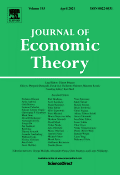Volker Benndorf, Ismael Martínez-Martínez, Hans-Theo Normann, 2021, Journal of Economic Theory, 195, 105281
Abstract:
We propose a model of coupled population games where intra- and intergroup interactions overlap. We analyze the general class of symmetric 2×2 games with coupled replicator dynamics in this framework. Standard one- and two-population predictions extend to a total of ten regions with different sets of attractors, among them novel hybrid points where one population randomizes and the other plays a pure strategy. Building on the theoretical analysis, we run continuous-time laboratory experiments using 48 different variants of coupled games. Observations confirm the theory to a large extent, but we also find a number of systematic deviations. When the attractors’ eigenvalues are smaller (in absolute terms), play converges to steady states located further from the prediction.
We propose a model of coupled population games where intra- and intergroup interactions overlap. We analyze the general class of symmetric 2×2 games with coupled replicator dynamics in this framework. Standard one- and two-population predictions extend to a total of ten regions with different sets of attractors, among them novel hybrid points where one population randomizes and the other plays a pure strategy. Building on the theoretical analysis, we run continuous-time laboratory experiments using 48 different variants of coupled games. Observations confirm the theory to a large extent, but we also find a number of systematic deviations. When the attractors’ eigenvalues are smaller (in absolute terms), play converges to steady states located further from the prediction.


